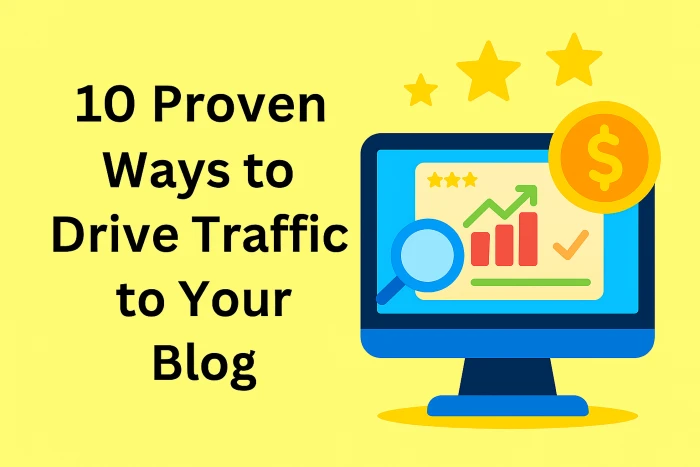Are you struggling to drive traffic to your blog? You’re not alone. Whether you’re just starting out or trying to grow an existing site, getting consistent blog traffic is one of the biggest challenges bloggers face. The good news? You don’t need a marketing degree or a massive budget to succeed. In this guide, we’ll break down 10 proven ways to drive traffic to your blog, even if you’re a beginner. These tips are based on real-world strategies that work in 2025 not outdated tricks. Let’s get started with the first six traffic-boosting techniques
1. Master the Basics of SEO to Drive Traffic to your Blog
Before you write your next blog post, make sure you understand the basics of SEO (Search Engine Optimization). It’s one of the most powerful ways to drive traffic to your blog organically. Start by doing keyword research using tools like Google Keyword Planner, Ubersuggest, or Ahrefs. Choose long-tail keywords that have a decent search volume but low competition.
Next, optimize your on-page SEO: use your target keyword in the title, meta description, URL, headers, and body text (just like this article does with “drive traffic to your blog”). Don’t forget image alt text and internal links to related posts on your site.
Also, improve your blog’s loading speed and make it mobile-friendly Google now prioritizes mobile usability and page experience.
Lastly, submit your site to Google Search Console and create an XML sitemap. These simple technical steps help search engines find and index your content quickly.
When your blog is optimized for SEO, you’re planting seeds for long-term traffic. It may take time, but SEO builds a steady stream of readers who are actively searching for your content.
2. Write Evergreen, High-Quality Content
To drive traffic to your blog, focus on creating evergreen content blog posts that remain relevant over time. These could be how-to guides, tutorials, listicles, or problem-solving content related to your niche.
High-quality content answers specific questions and provides real value. Use clear formatting with headers, bullet points, and short paragraphs to keep your posts readable. Include helpful images, infographics, or videos where appropriate.
Try to cover topics more comprehensively than your competitors. Use tools like Answer the Public or Google’s “People Also Ask” section to find related questions and address them in your post. The more useful your content is, the more likely people are to link to it or share it.
Update your content regularly to keep it fresh. Google rewards sites that maintain current, accurate information.
Most importantly, ensure your post includes your target keyword “drive traffic to your blog” naturally throughout the content. Avoid keyword stuffing, but mention it enough to help search engines understand the topic. This strategy boosts your chances of ranking higher on Google, leading to more organic traffic over time. Take a look about Online Business Start-Ups for Teens and Students: A Smart Move or a Risky Distraction?
3. Promote Your Blog on Social Media
Writing a great blog post isn’t enough you have to promote it. Social media platforms like Facebook, Twitter (X), Instagram, LinkedIn, Pinterest, and TikTok are powerful tools to drive traffic to your blog.
Start by identifying where your audience spends time. For example, if your blog is about fashion or DIY, Pinterest is perfect. If you write about business or career tips, LinkedIn might be a better fit.
Create eye-catching visuals using free tools like Canva, and pair them with compelling captions. Use relevant hashtags and don’t be afraid to reshare older content regularly.
Join relevant Facebook groups or Reddit communities where your content adds value (but avoid spamming). Engaging genuinely in these spaces can lead to significant traffic.
Don’t just post links provide value, ask questions, run polls, or tell a story related to your blog topic. This helps build a community and encourages click-throughs.
You can also schedule posts using tools like Buffer or Later to maintain consistency. With regular, thoughtful promotion, social media can become one of your top sources of blog traffic.
4. Build an Email List Early
If you want a reliable way to drive traffic to your blog, start building an email list from day one. Unlike social media platforms — where algorithms can limit your reach — email gives you direct access to your audience.
Use a lead magnet (like a free checklist, eBook, or course) to encourage visitors to subscribe. Services like MailerLite, ConvertKit, or Mailchimp make it easy to create signup forms and automate emails.
Once you have subscribers, send regular newsletters that provide value — such as tips, updates, or exclusive content. Always include links back to your latest or most relevant blog posts.
Segment your list based on interests or behavior to improve engagement. For example, if someone downloads a guide on “SEO for Beginners,” you can send them related posts on blog traffic or ranking tips.
Email marketing doesn’t just drive short-term traffic; it helps build a loyal audience that returns to your blog repeatedly. And the more your readers engage with your content, the more likely they are to share it, helping you reach new audiences organically.
5. Leverage Guest Posting and Backlinks
One of the most effective ways to drive traffic to your blog — and improve your domain authority — is by writing guest posts on other blogs in your niche. This strategy helps you reach new audiences and earn valuable backlinks, which boost your SEO.
Start by identifying blogs that accept guest contributors. Pitch high-quality, relevant article ideas that fit their audience. Include a brief author bio with a link to your blog or a specific post.
Backlinks from authoritative sites signal to Google that your content is trustworthy. As a result, your own blog posts are more likely to rank higher in search results.
In addition to guest posting, look for backlink opportunities through:
- Broken link building
- Blog collaborations
- Expert roundups
- Podcast appearances
Each time your blog is linked from another reputable source, it acts like a vote of confidence. Over time, these links compound and dramatically increase your organic visibility — bringing in more readers without you having to pay for ads.
6. Repurpose Your Content Across Platforms
One smart way to drive traffic to your blog is by repurposing your existing content into different formats for different platforms. This extends the life of your blog posts and increases the chances of discovery by new audiences.
For example:
- Turn a blog post into a YouTube video
- Break it into short clips for TikTok or Instagram Reels
- Create a SlideShare or carousel post for LinkedIn
- Turn stats into an infographic for Pinterest
Repurposing saves time and helps you reach audiences who prefer different types of content (video, audio, visuals, etc.).
You can also compile multiple related blog posts into a downloadable eBook or email course — great for growing your list while reusing existing material.
Each new format links back to your original blog post, creating more entry points for traffic. Over time, this multiplies your exposure and helps build your authority across multiple channels.
Repurposing content is not just smart — it’s essential for long-term content marketing success.
7. Collaborate with Influencers and Niche Bloggers
Collaborating with influencers and niche bloggers is a smart way to drive traffic to your blog, especially if you’re just starting out and don’t have a big following. Influencers already have the attention of your target audience — and a single mention from the right person can send a wave of traffic to your content.
Start by identifying micro-influencers in your niche who have an engaged audience, even if they don’t have massive followings. Engage with their content authentically before reaching out. Offer to collaborate on:
- Guest posts
- Expert roundup articles
- Social media takeovers
- Joint live sessions or webinars
You can also offer to feature them in your blog posts, increasing the likelihood that they’ll share your content in return.
The key here is mutual value. If you’re providing helpful content or exposure to their audience, they’ll be more likely to support your blog.
Collaboration helps build credibility, expands your reach, and positions you as part of a larger community — all of which ultimately help you drive traffic to your blog in a sustainable, relationship-driven way.
8. Optimize for Featured Snippets
Featured snippets are those “position zero” results that appear above all other listings on Google. If you optimize your posts for them, they can drive traffic to your blog without needing the #1 ranking spot.
To increase your chances of earning a featured snippet:
- Answer specific questions in a clear, concise way (in 40–60 words).
- Use structured formatting — such as numbered lists, bullet points, or short paragraphs.
- Include headings like “What is…”, “How to…”, or “Why does…” to match common search intent.
For example, if your post covers “How to drive traffic to your blog,” include a section that clearly answers that question in a scannable format.
Use schema markup to help Google understand your content structure better. You can also find snippet opportunities by searching your main keyword and analyzing which types of snippets already appear — then model your content after that structure.
Snippets aren’t guaranteed, but even a few can dramatically increase your visibility and organic traffic.
Snagging a featured snippet is like getting a free billboard at the top of Google — and it’s one of the fastest ways to drive traffic to your blog without spending money.
9. Use Paid Ads Strategically
If you want quick results, consider using paid ads to drive traffic to your blog. Platforms like Google Ads, Facebook, Instagram, Pinterest, and even Reddit allow you to target specific demographics based on interests, location, behavior, and more.
Start small with a limited budget. Promote your highest-performing blog posts, lead magnets, or cornerstone content. The goal isn’t always to sell something — sometimes, you just want more eyeballs on your site to build brand awareness and engagement.
Use compelling headlines, clear visuals, and strong calls-to-action (CTAs). Make sure your blog’s landing page is optimized for conversions — whether that means newsletter signups, social shares, or product clicks.
Retargeting is another powerful tactic. You can show ads to users who’ve already visited your site but didn’t take action. This keeps your blog top of mind and brings visitors back.
Paid traffic isn’t a long-term replacement for SEO or organic growth, but when used correctly, it’s a great way to jumpstart momentum and drive traffic to your blog while you build other channels.
10. Answer Questions on Quora and Reddit
If you’re looking for highly targeted ways to drive traffic to your blog, answering questions on platforms like Quora and Reddit can be incredibly effective.
These platforms are filled with users actively seeking answers — and if your blog content aligns with those questions, it’s a perfect match. Look for relevant subreddits or Quora topics related to your niche. Use the platform’s search function to find recent questions you can genuinely answer.
When you respond:
- Be helpful and thorough.
- Avoid being overly promotional.
- Add value first, then include a link to your blog only if it directly supports your answer.
This positions you as an expert and builds trust with readers. If people find your answers helpful, they’ll likely click through to your blog to learn more — which helps you drive traffic to your blog in a very targeted way.
Over time, your answers may rank in Google search results too, creating additional long-term traffic opportunities from a single response.
11. Publish Consistently and Stick to a Schedule
One underrated but powerful way to drive traffic to your blog is to publish content consistently. When readers (and search engines) see that you update your blog regularly, they start to trust your site as a reliable source of information.
You don’t have to post daily — just be consistent. Whether it’s once a week, bi-weekly, or twice a month, stick to a publishing calendar.
Consistency builds:
- Reader trust
- SEO momentum
- Social media rhythm
- Content for repurposing and email campaigns
Use a content calendar to plan upcoming posts, keywords, and promotion strategies. Tools like Trello, Notion, or Google Sheets work great for managing your publishing schedule.
Consistency also helps you build better writing habits, stay ahead of competitors, and create a larger content library over time. More content = more opportunities to rank and attract new visitors.
Even if you’re short on time, focus on quality over quantity. A well-written post every two weeks will perform better than daily low-effort content.
In short: publish often, publish with purpose — and it will drive traffic to your blog consistently over time.
12. Analyze and Improve What’s Already Working
Finally, one of the smartest ways to drive traffic to your blog is by analyzing what’s already working — and doubling down on it. Use tools like Google Analytics, Search Console, and Hotjar to see:
- Which posts get the most views
- Where your traffic is coming from
- What keywords you’re ranking for
- How users behave on your site
Update high-performing blog posts with new information, better visuals, or updated SEO. Add internal links to newer content to keep readers on your site longer.
If a specific type of post performs well (e.g., listicles, tutorials, reviews), create more content in that format. If a particular topic is driving results, build related clusters around it.
Sometimes, small tweaks — like improving your title, meta description, or intro paragraph — can result in major gains.
Tracking performance also helps you stop wasting time on strategies that don’t work. When you optimize based on data, you’re not guessing — you’re growing.
Analyzing your blog’s traffic is the final (and ongoing) step in ensuring everything you do continues to drive traffic to your blog over the long term.




